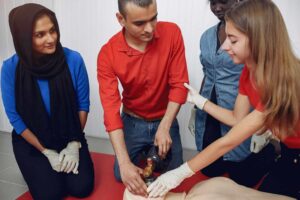Table of Contents
ToggleHave you ever witnessed a situation where someone collapsed before you, and you had no idea what to do next other than call medical help? Ofcourse, that seems terrifying to find someone in such a scenario. But instead of watching the person struggling for life till the medical help arrives, you can help them bring their heartbeat back with CPR.
Cardiopulmonary Resuscitation (CPR) is an emergency procedure that is performed by pressing the chest and rescuing breathing to keep the person’s blood circulating and oxygenated until medical help arrives. This blog will provide the important techniques and skills of CPR training to help you save lives and make a difference in emergencies.
Performing chest compressions: One of the initial lessons in CPR training
Whether you put more or less salt, this inaccurate amount of it will make the food unpleasant or distasteful. That’s why Precision and accuracy are essential. Similarly, one must know how many compressions to give per minute while giving CPR. A medical Association, American Heart Association (AHA), recommends the compression rate should be 100-120 per minute. This ensures enough blood circulation throughout the body and increases the chance of survival for the individual in need.
How to perform chest compressions
Even if you know the count, you won’t be able to give CPR until you learn the technique of performing compressions. To perform compressions, ensure the individual is on a hard surface. If not, find the hard surface and place him, and kneel beside him. The second step is to interlock your hands and place them below the nipple line at the center of the person’s chest. Make sure that your elbow is straight. By using the weight of your upper body, push down firmly on the chest, allowing it to recoil entirely between compressions. Remember to keep at least 2 inches depth for the compressions in adults.
Providing Rescue Breaths
Your job of performing CPR doesn’t end with performing Compressions. Rescue breaths are in line too. While compressions circulate the blood, rescue breaths deliver oxygen to the lungs of the needy individual. CPR training will teach you to the importance of both processes. First, check whether the person can intake air for rescue breaths. Make their airway clear by lifting the chin and tilting the head back. Later, create a seal over their mouth with your own and pinch the nose. Take a normal breath in that position and provide two rescue breaths. Each should last for about one second. Watching that the person’s chest rises and falls when you give rescue breath is important. It ensures that the technique is working and oxygen is circulating.
Recently, the ratio of compressions and rescue breaths has changed in the CPR technique. According to AHA’s suggested guidelines, CPR is now performed by giving continuous compressions without rescue breaths in most adult cardiac arrest cases. This method is known by the name of Hands-Only CPR. As per o0bservations, this method is as effective as traditional CPR. However, you can provide rescue breaths if you are trained in CPR and feel confident.
Role of Automated External Defibrillator (AED)
CPR training will also teach you to use an Automated External Defibrillator (AED). AED is a portable device that delivers an electric shock to restore the heart’s rhythm of someone who is in cardiac arrest. It is an easy-to-operate device and requires very little training. You can find these devices often in public places such as airports, schools, shopping malls, and sports arena. In CPR training, you’ll learn the complete operation of AED that, begins with learning how to place the AED pad on the chest and follow the prompts to give shock. These devices are essential in increasing the survival chance of individuals having a cardiac arrest.
Besides technical skills, CPR training also focuses on staying calm and composed whenever an emergency arises. It trains you to judge the situation and handle the individual, prioritizing actions and communicating with emergency medical services.
CPR techniques for different age groups
CPR is indeed an important skill. If acquired with proper training, one can make all the difference by saving lives during emergencies. Cardiac arrest is one such emergency, and CPR can increase the survival chance of an individual having a cardiac arrest. Let’s see how it is performed on adults and children and how the techniques differ.
CPR instructions for adults
CPR works as a boon in saving life, but it performs differently on adults than on infants and children. During your training, you’ll learn all the instructions on CPR on adults, like correct hand placement, hand position, and compression depth. In adults, the compression rate is 100 to 120 per minute, and the compression depth should be at least 2 inches. At the same time, the number of rescue breaths should be two every 30 chest compressions. Rescue breaths in adults are given by pinching the nose and covering the mouth with the rescuer’s mouth.
While giving CPR to an adult, check the clothing. If the person is wearing a shirt or something with buttons on top, open it up to get their chest. Also, they are on a hard surface. Make sure to cover it with a towel or blanket under their back. This helps to cushion their chest.
CPR instructions for children and infants
In infants, the CPR technique is performed a bit differently. The methods are identical, but the counts differ. The compression rate here is 120 to 150 per minute, and the compression depth should be about 1 inch. At the same time, the number of rescue breaths should be two every 15 chest compressions. Rescue breaths in infants or children are given by placing the rescuer’s mouth over the infant’s mouth and nose.
For infants, you must use two fingers to perform the compressions while placing your fingers on the lower half of their breastbone, just below the nipples. Be gentle and avoid tilting the head back too far.
Gateway to Saving Lives and Career Opportunities
By acquiring training in CPR, you get equipped with all the necessary skills and techniques to save lives. This doesn’t require an exceptional degree, as anyone can perform it anytime during an emergency. Whether you are a teacher, a working professional, a teacher, or a simple citizen, CPR training is a valuable skill everyone should learn. It allows you to confidently tackle a cardiac emergency and improve the chance of survival.
CPR training also opens up career opportunities for you. Many sectors, including security, need employees to have CPR certification. This training can demonstrate your commitment to safety and ability to handle emergencies.
Conclusion
In the end, training has not been taken to add another skill to your resume but is an essential skill that can save a life and make you a life savior that people will remember. Whether it is your loved one or a stranger, you can help them escape the fatal situation. By acquiring this training, you make a difference in someone’s life. Don’t wait for emergencies to happen. Instead, be prepared for it. Take the CPR training with Multisec and be ready to act when it matters the most. Because that time you won’t be starting but working for a good cause.
For more information, call us on 1300 891 503. Alternatively, complete your details at https://multisectraining.edu.au/contact-us/, and one of our friendly team will get back to you.





